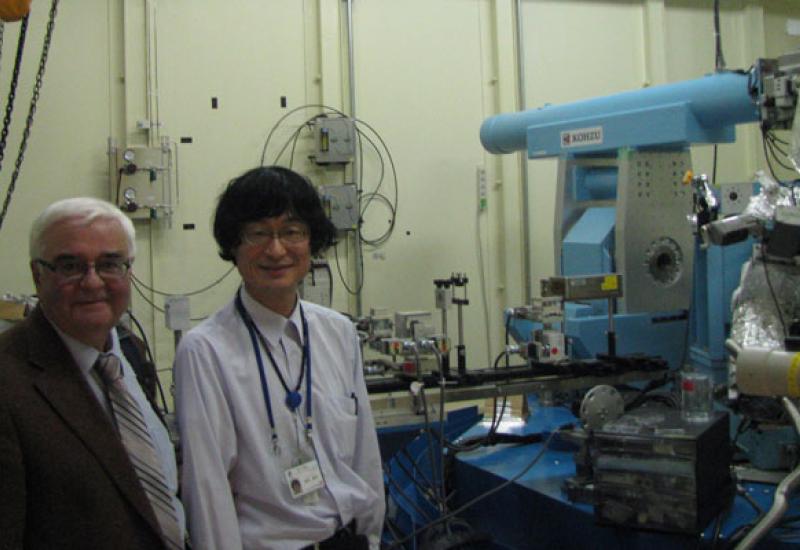In December 2013 Vice-Principal of "KPI" prof. Sergey Sidorenko was in Japan. During the visit, he were on Synchrotron complex "SPring-8", the headquarters of "Ryhaku Corporation" and Tokyo plant, Tokyo University of Agriculture and Technology, Embassy of Ukraine in Japan. On interesting meetings and cooperation with the countries of the Rising Sun Sergei told readers' in Kyiv Polytechnic newspaper.
One year ago ... Extraordinary and Plenipotentiary ambassador of Japan to Ukraine Toichi Sakata took the initiative to help to build cooperation with KPI research center "SPring-8". This world's most powerful synchrotron complex of third generation (all known Hadron Collider is the fifth generation of accelerator - the only one in the world), in which electrons are accelerated to energies of 8 GeV.
The starting meeting towards the establishment of collaboration was the visit of the Director of "SPring-8" Dr. Tetsuya Ishikawa to Kyiv Polytechnic in January 2013. With his participation a seminar on "New Horizons in scientific and technological cooperation with Japan" was held and an acquaintance of KPI scientists working in the field of physics and chemistry of solids was arranged. Then the Japanese guests visited the University Teaching and Research Center of X-ray analysis of "KPI", RYHAKU.
Later in July, a Memorandum of Mutual Understanding of a "SPring-8" was signed. In the same month Kiev Polytechnic was honored to receive the Nobel Laureate, President of the Japan Institute of Physical and Chemical Research "RIKEN", which includes "SPring-8", Dr. Noyori Rodzhi. During negotiations, agreement was reached also on cooperation with "RIKEN".
At the invitation of Dr. Ishikawa Sergei became the first Ukrainian scientist who visited the "SPring-8". During a meeting with Japanese partners further areas of collaboration were identified: interdisciplinary investigations at the intersection of physics and chemistry of solids, biotechnology (including fundamental studies of the structure of water), and the fundamentals of applied medicine and so on. Of course, other researchers who work in the field of basic research and want to try themselves in the center of the "SPring-8" are invited to cooperation.
At the request of the Japanese partners professor Sergey Sidorenko presented an overview report on the development of "KPI" research in solid state physics. The report was presented to the newly created next to "SPring-8" Research Center SACLA (SPring-8 Angstrom Compact Free Electron Laser) - the fourth generation of accelerators costing about $ 1 billion, which technically accomplished radiation of wavelength 0.63 A ° and is about to be accomplished with parameters at 0.4 ° with locality beam of 0,001 mm x 0,001 mm. For comparison, we recall that the distance between the atoms in the crystal lattice of copper is 3.614 A °. This means that humanity is closely approaching the technological capabilities to explore the structure of matter in fire technics dimensional scale!
The second part of the visit to Japan was devoted to work in the corporate headquarters "RYHAKU" and at the Tokyo plant - one of the world's leading manufacturers of equipment for X-ray analysis and other types of analytic-art equipment. During the talks issues of preparation and holding seminar on current issues diffraction analysis involving experts "RYHAKU" in May 2014 on the basis of "KPI" was discussed
Professor Sergei Sidorenko visited also Tokyo University of Agriculture and Technology, which recently has signed an agreement on cooperation and student exchanges.
Work in Japan was ended by the meeting with the Ambassador of Ukraine in Japan Yuri Kharchenko and Chancellor George Kushna to discuss the prospects of cooperation with Japan through the activities of Ukrainian-Japanese Center "KPI", in what our university is full of support from the Embassy of Ukraine in Japan.
Impressions and seeing new possibilities of cooperation on scientific and technical areas of Japan, which were received during the visit, will be communicated not only to scientists of KPI, but also to other universities and scientists of the NAS of Ukraine.
| Attachment | Size |
|---|---|
| 1401-2_1.jpg (68.5 KB) | 68.5 KB |

